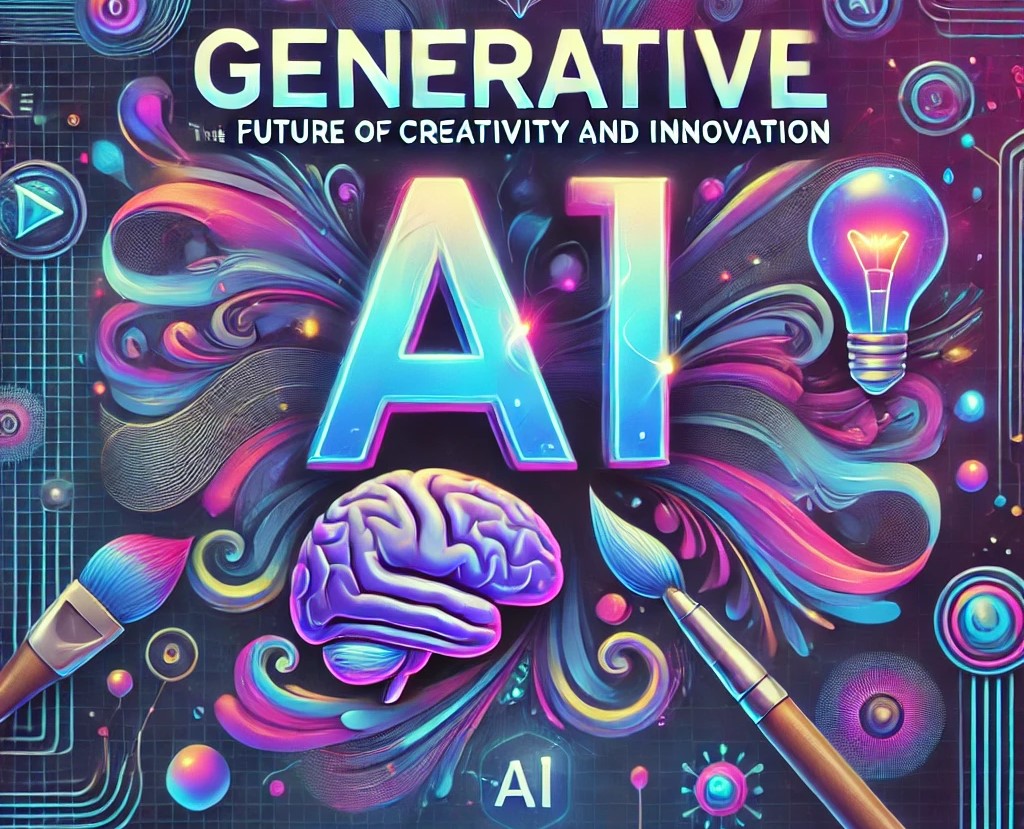Explore how generative AI is revolutionizing creativity and innovation across industries. Learn about its impact on art, design, business, and more, and discover the future possibilities of this transformative technology. Ideal for tech enthusiasts, creatives, and anyone interested in the future of AI.

What Is Generative AI?
Generative AI refers to a category of artificial intelligence models that can generate new and original content. Unlike traditional AI, which focuses on recognizing patterns or analyzing data, generative AI creates things—such as images, music, text, or even entire virtual environments. It relies on advanced machine learning algorithms like Generative Adversarial Networks (GANs) and models like GPT (Generative Pre-trained Transformer) to craft content that mimics human creativity.
For instance, if you’ve ever seen AI-generated art or read an article draft created by ChatGPT, you’ve witnessed the power of generative AI innovation first-hand. Companies like OpenAI, Google, and even AWS Generative AI Innovation Centres are at the forefront of developing these technologies.
How to Use Generative AI Effectively
Generative AI is a powerful tool that can transform various tasks, from writing and design to data analysis. Here’s how you can use it effectively:
- Content Creation: Writers, bloggers, and marketers use generative AI tools like Jasper AI or Copy.ai to speed up content production. These tools can generate ideas, draft entire blog posts, or suggest social media copy.
- Art and Design: Artists and designers use platforms like DALL-E and Midjourney to create unique visual pieces. The key to using these tools effectively is to experiment with prompts and refine the AI’s output to fit your vision.
- Music Composition: Musicians are experimenting with generative AI to produce new sounds and compositions. AI tools like Amper Music or AIVA assist artists in generating unique melodies or entire musical scores.
- Code Generation: Developers use tools like GitHub Copilot to assist with coding tasks, making programming faster and more efficient.
Tips for Effective Use:
- Be Specific with Prompts: The more detailed your input, the more accurate and relevant the output.
- Review and Edit: Always review the AI’s work and make necessary adjustments to ensure quality and authenticity.
- Combine AI with Human Creativity: Use generative AI as a collaborative tool rather than a replacement for human creativity.
Real-World Examples of Generative AI Innovation
Generative AI is already making waves in multiple industries. Here are some noteworthy examples:
- Art and Culture: AI-generated art has taken the art world by storm. In 2018, a piece created using generative AI sold for $432,500 at Christie’s auction house. Platforms like Runway ML empower artists to experiment with AI-driven designs.
- Film and Animation: Directors and animators are using generative AI to create hyper-realistic visual effects or even automate parts of the animation process. AI-driven software can generate scenes, characters, or background art.
- Healthcare: In healthcare, generative AI innovation is helping in drug discovery. For example, DeepMind’s AlphaFold uses AI to predict protein structures, accelerating research in medicine.
- Business and Marketing: Companies use AI to personalize content, automate marketing strategies, and improve customer experiences. For instance, AWS Generative AI Innovation tools help businesses harness the power of AI for customized solutions.
How to Learn Generative AI
If you’re inspired to explore generative AI creativity yourself, numerous resources are available:
- Online Courses: Platforms like Coursera, Udemy, and edX offer courses on generative AI, neural networks, and machine learning. Search for courses taught by reputable instructors, such as “Deep Learning Specialization” by Andrew Ng.
- YouTube Tutorials: Channels like Two Minute Papers and Yannick Kilcher explain complex AI concepts in an easy-to-understand manner.
- Books and Publications: Books like “Deep Learning“ by Ian Goodfellow or “Artificial Intelligence: A Guide to Intelligent Systems” provide foundational knowledge.
- Generative AI Innovation Canter: Check out initiatives like AWS Generative AI Innovation Canters for practical resources, workshops, and industry-specific use cases.
Actionable Tip: Start with the basics of machine learning before diving into generative AI. Understanding foundational concepts will make learning advanced AI topics easier.
Conclusion
Generative AI is a game-changer, transforming how we think about creativity and innovation. From automating tasks to enabling artistic expression, the possibilities are endless. As technology continues to evolve, being informed and adaptable will be key. Whether you’re a student, a professional, or simply curious, there’s no better time to dive into the world of generative AI innovation.


It is the best time to make some plans for the future and it is time to be happy.
I’ve read this post and if I could I wish to suggest you some interesting things or
suggestions. Maybe you can write next articles referring to this
article. I wish to read more things about it!
Thank you for your thoughtful comment! 😊 I’m glad you enjoyed the post. I appreciate your suggestions and will definitely consider them for future articles. Stay tuned for more! 🚀
I love your blog.. very nice colors & theme.
Did you create this website yourself or did you hire someone to do it for you?
Plz reply as I’m looking to construct my own blog and would like to find out where u got this from.
kudos
Thank you for the kind words! 😊 I created the site myself using inbuild theme. If you’re starting your blog, platforms like WordPress or Squarespace are great. Let me know if you need tips—good luck! 🚀